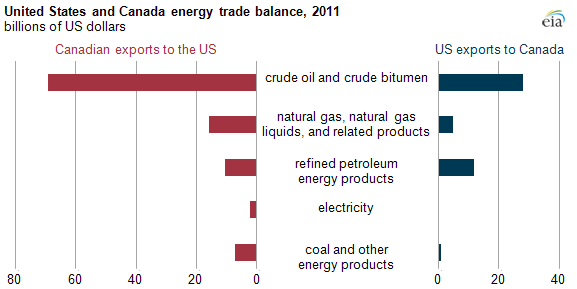
Sources: U.S. Energy Information Administration, based on Statistics Canada.
The United States and Canada form the largest integrated energy market in the world. Energy trade between these countries exceeded $100 billion dollars (U.S.) in 2011. Together, they establish a continental market for energy across many types of fuels and products—petroleum products, natural gas, electricity, hydropower, coal and others. Currently, the bulk of energy by both trade dollars and physical volumes moves from Canada to the United States, although for some energy commodities the reverse is true.
• Tight integration of energy markets across the U.S.-Canada border is apparent in many ways:
• Interconnected power grids, cross-border electricity markets, and reliability entities
• Integrated network of petroleum products and natural gas pipelines supporting seamless movements across both countries
• Numerous trading-point benchmarks such as the AECO-C natural gas hub in Alberta, Canada, that inform price discovery, commercial decision-making, and trading in both countries
• Joint ownership of some energy assets and infrastructure by U.S. and Canadian firms
• Rapid, seamless transfer of technology and market information
• Mutual use of key ways to store energy at strategic locations such as Dawn, Ontario, for natural gas, Cushing, Oklahoma, for crude oil, and reservoirs in Canada for hydro production
Below is a summary of trade in oil and gas...
Petroleum: Canada is the largest supplier of foreign oil to the United States. Canada accounted for approximately 25% of U.S. crude oil imports in 2011. The United States imported 2.8 million barrels per day (bbl/d) of oil and petroleum products from Canada in 2011, of which 2.2 million bbl/d were crude oil. Cross-border oil trade, however, flows in both directions. The United States exported about 305 thousand barrels per day of petroleum products and 46 thousand barrels of crude oil per day to Canada in 2011.
Natural Gas: Canada remains a key exporter of natural gas to the United States. The United States imported about 8.5 billion cubic feet per day (Bcf/d) of natural gas from Canada in 2011, down from near-peak levels of 10.4 Bcf/d in 2007. Canada accounted for almost 90% of overall U.S. natural gas imports in 2011, most of which came from western Canadian provinces. Although the United States is a net importer of natural gas from Canada, it exported more than 900 Bcf of natural gas to Canada in 2011, up from less than 100 Bcf in 2000. New pipeline projects in the northeastern U.S. could transport increasing amounts of natural gas to Canada, especially from the Marcellus Basin, though some of that gas may be re-exported by Canada into other parts of the northeastern United States.
Source: EIA

No comments:
Post a Comment